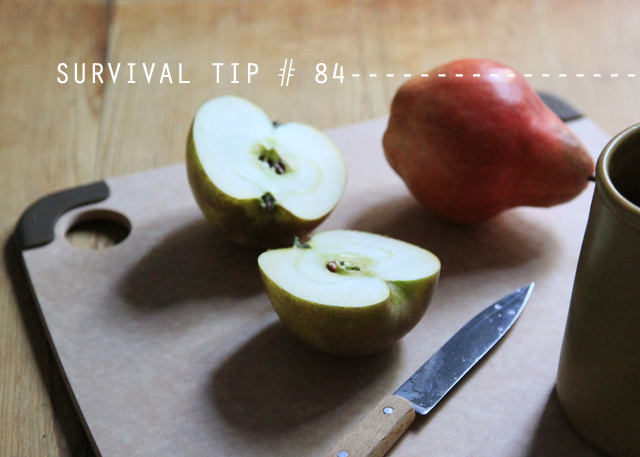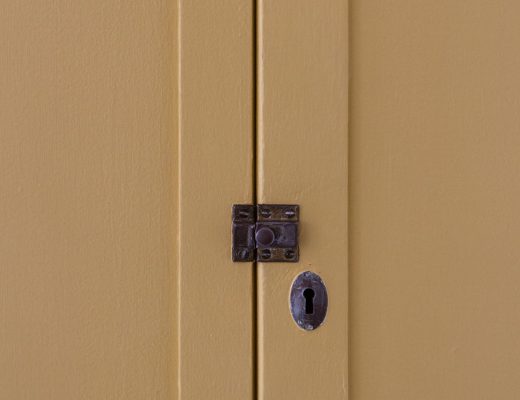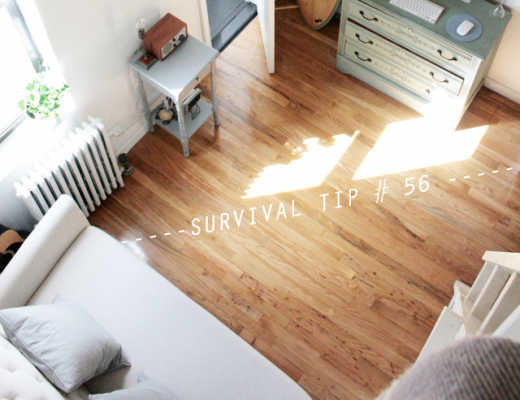
Tip #84: Consider your cutting boards.
Last Sunday, after going to the grocery store, James and I wandered into a local kitchen shop to browse.
As we wandered among the shelves crammed with every useful and preposterous kitchen implement you can imagine, we came across a stack of whisper thin cutting boards. Well. We’ve been using the same awkwardly shaped and warped cutting board for the last seven years. As is wont to happen in a moment of weekendly weakness, I began stroking the svelte boards longingly.
We squabbled briefly over the size of the board we should get, then “compromised” and got one in the medium size, as I proposed. It’s big enough so that the butternut squash won’t fall tumbling to the floor, but small enough to balance on our tiny countertop and slide seamlessly into our cabinet. It’s not the prettiest thing on the planet, but it’s practical for the space we have. And storing ten tiny cutting boards in a tiny apartment is a lot harder than storing one regular-sized one.
The packaging on the board touts that the board is made from recycled FSC wood, which is lovely sounding, and I’ve been coming up with excuses for chopping things since coming home. Alas, this morning I did a bit of due diligence before squawking too loudly about my new found love and I’ve read a few disconcerting reports of a formaldehyde-based resin, so I’ve written a note to the manufacturer and am hoping to hear back soon.
Buying stuff is hard. Any favorite cutting boards out there?




12 Comments
This just in: a bit more about the resin, from Epicurean:
"Richlite, the material we use to make our cutting surfaces, is made with sheets of paper and phenolic resin, which does contain minute trace amounts of formaldehyde, however, most of the VOC’s are in essence burnt off during the manufacturing process. The material is approved by the NSF (National Sanitary Foundation – see attached certificate) to be non-toxic and it has also been tested and approved by GreenGaurd (www.greenguard.org) which tests products for safety for use within homes and schools. Both certificates from GreenGuard are attached for your reference.
The boards are also approved by the NSF (National Sanitary Foundation) which is the leading 3rd party health and food safety company that sets the standard in which food safety is measured. The material has also been used in commercial kitchens for over 50 years.
Please be confident that the boards are completely non-toxic and are safe for you to use."
we use ecosmart poly-flax cutting boards. we have 2, and I honestly think we could justify having one more. they are heavy enough that they won't slide around, the handle at the top ensures that it won't slip out of your hands when you're washing it (hey, it happens more than you think with non-handled boards), and it's slim enough to slide behind our plates stack in our open shelves above the sink… i'd say they each get used/washed at least twice a day, we've had them for 3 years, and they are as good as new. made in the USA, made of 100% recycled food-grade plastic, the only thing missing is a "tray" around the edge for catching meat juices….
bed bath and beyond sells them, but many local kitchen stores do too, we bought ours at a kitchen store in philly….
http://www.bedbathandbeyond.com/1/1/17993-ecosmart-poly-flax-green-12-inch-l-x-16-inch-w-cutting-board.html
cheers!
I have a small Epicurean board, which I love, except for the fact that it slides around when cutting on it. I don't feel that's very safe to have a board sliding around when using sharp knives and it's a pain to always have to put a wet cloth underneath to keep it from sliding around. Is this a problem with your board? I also wonder about how hard the resin is on the knives.
Hi there: The edges of this board have rubber grips to prevent slipping, and they've worked well so far!
I heard a really good tip about buying one that will fit across your sink when you have a small space.
The one that fits across my sink, thus giving me an actual — albeit small — counter.
Ah, yes. But I've always had trouble finding the space to store such a large board when it's not in use!
I don't have one because they're too big for my small kitchen…but someday I am going to get a Boos block and oil it up every so often.
Because of reading several articles such as this (http://www.nytimes.com/1993/02/10/health/wooden-cutting-boards-found-safer-than-plastic.html), I choose to use wood cutting boards such as J.K. Adams or local sources. I find them to be more attractive and apparently safer than most other options.
One for meat, one for everything else is our rule. I think right now we have two of each.
This is one of those challenges of having a small home that nome ever imagines. I recently moved in a 530 square foot apartment with my SO. When the time came to decorate our 60 square foot kitchen I had my mind set in the Ikea Lamplig cutting board. My SO had a really hard time convincing me it was to big for our small kitchen. I kept insisting that we needed it to compensate for the lack of counter space. What finally convinced me to buy a smaller one was the fact that we didn’t had a place to store it when not in use.
I have a small solid mesquite wood cutting board that I bought at the Tucson Botanical Gardens years ago. It has a hole in the handle that I thread a piece of twine through for hanging. For 20 years it has been my daily favorite and will most likely be in my will to my goddaughter. I have two other cutting boards, both of solid slab olive wood. One is for cutting watermelons and other big fruits or vegetables. The other is twice the size of my mesquite board and useful for lining up slices of bread for sandwiches, cutting winter squash and slicing large onions and cauliflowers. Yes, three. I have less of other kitchen equipment so I may revel in my cutting boards.
Comments are moderated.